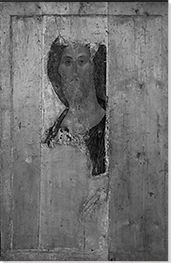Summary of Andrei Rublev
The Russian Orthodox Church has over the centuries become renowned for its religious painters but it is Rublev's exquisite icons and frescoes that rank him the most important of all the late medieval Russian masters. His name has become inextricably linked with one of the most important periods in Russian painting and he is attributed with bringing about the revival of Byzantine art following its demise under the Ottoman rule. His fine modelling, and feel for pictorial depth, offered a subtle step away from the flat hieratic traditions of Byzantine art. Indeed, Rublev challenged the severe rules and traditions of Byzantine Christian art bringing forward a wistful perception of celestial beauty and a deeply pensive and introspective dimension to his art. Rublev lived through a deeply troubled period in Russian history yet his paintings revealed, through his devotion to God, a deep compassion and calm.
Accomplishments
- Whereas Byzantine painting had tended towards the sinful and cataclysmic, the "Rublev rival" (as some have called it) brought a new optimism and light to religious painting. His icons and frescoes were formed of light and gentle color bringing a new harmony to the art of Russian Orthodox iconography.
- Rublev's icons possess a sense of realism that showed a level of sophistication that in some ways echoed the work of the Italian Naturalists. Hitherto, the convention of Byzantine iconography was for the subjects to engage the viewers' gaze directly whereas Rublev's subjects typically averted the direct gaze of the viewer. This strategy allowed for a more private mode of worship and it was to be duly adopted by the Moscow School of Iconography - the school allowed for a general relaxation of the severe intensity of traditional iconographic painting thereby effecting a more worldly relationship between state and church.
- Rublev would often test the conventions of icon painting by doing away with a narrative plot line, preferring to focus on a single moment. He strived to do more than tell religious stories and he used painting to evoke a higher feeling. Rather than position his worshipers outside the scene, his works invited them a route into the painting through deep contemplation and spiritual reflection.
- Rublev's peaceful and quiet figures are rendered in an economy of elegant lines and contours and a subtle, yet minimal, modelling of facial features. His work brought an element of authenticity and intense personal feeling that was only matched by those Italian masters; the likes of Giotto and Masaccio, who were associated with the period of the proto/early Renaissance.
Important Art by Andrei Rublev
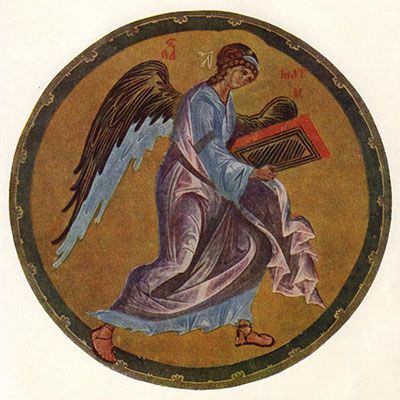
The Man of Matthew
The Khitrovo Gospel is a Russian gospel book of eight full-page miniatures from the late 14th or early 15th century. The miniatures feature four Evangelistic portraits and four pictures of their symbols: the angel, the bull, the lion and the eagle. Though some historians are willing to attribute all the miniatures to him, the angel, the symbol for the evangelist Matthew, is the only one about which there is general consensus that it is a Rublev. A young winged boy is placed within a circle. The figure's elegant line and contours, its soft coloring of azure blue and fresh green, and the boy's expressive facial features, lend the image a lightness and gayety that was typical of Rublev's style.
The Khitrovo Gospel is based on East Slavic manuscripts of the 1390s. It takes its name from Bogdan Khitrovo, a boyar who obtained the original Slavic manuscripts from Tsar Fyodor III. Khitrovo subsequently bequeathed the manuscripts to the Trinity Monastery where Rublev was a monk. Following the nationalisation of monastic libraries in the early 20th century, the Khitrovo Gospel was incorporated in the holdings of the Russian State Library in Moscow.
Russian State Library, Moscow
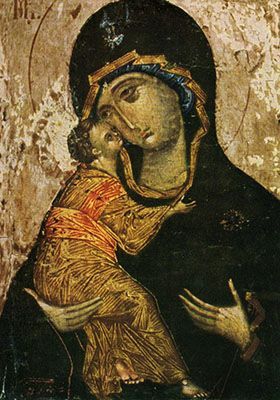
The Virgin of Vladimir
This piece, attributed to Rublev, is a copy or the "original" or "first" Virgin of Vladimir which now lives in the Tretyakov Gallery. The original was gifted to the Great Prince of Kyiv in 1130 from the Patriarch of Constantinople and has survived to become one of the most venerated icons of the Russian Orthodox Church. It is a typical example of Byzantine Iconography and has been copied countless times. Within the Orthodox Church it is believed that the copies of a sacred icon possess the same divinity as the original. Rublev's version, though compositionally almost an exact replica, reveals some significant differences. For instance, the Virgin's head has what would be later recognized as a typical Rublev tilt, a deeply tender inclination. Even this slightest deepening of angle from the original lends a greater and more powerfully recognisable emotional connection between mother and son. In addition to this nuance, the rendering of the skin and faces of the pair in Rublev's icon have a realism of great sophistication for the time. The Virgin Mary's gaze is directed out to the left over her child's head, rather than directly towards the viewer (which was at that time a convention within Byzantine Iconography). This was an alteration in style that was to become a trait of the newly emerging Moscow School of Iconography. It gives the viewer the sense of being party to a private devotional moment and adds an intimacy to their worship before the icon.
Tempera on Wood - Museum of Valdimir Suzdal
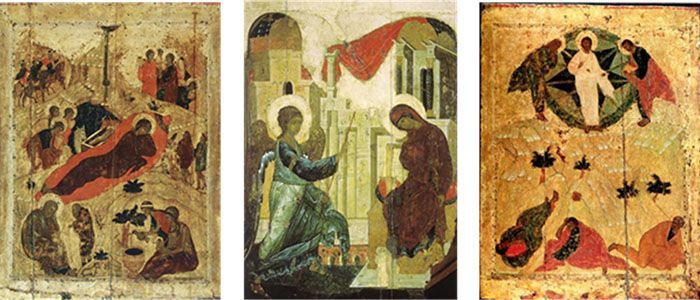
The Nativity, The Annunciation and The Transfiguration
These three icons are from the work Rublev was commissioned to do in The Annunciation Cathedral in Moscow in 1405 with Theophanes the Greek and Prokhar of Gorodets with the three being attributed to Rublev.
True to the thematic conventions of The Nativity story, Rublev's painting represents Mary reclining in centre frame with the baby Jesus, attended by the Ass and the Ox. The three Magi ride to meet the baby from the top left corner while Joseph is isolated in the bottom left, being enticed by the devil who is trying to exploit his lesser role in the birth narrative. In the bottom right hand corner, are the midwives, symbolising the corporeal nature of the birth of the son of God. The Annunciation shows the moment the angel visit Mary and tell her of her pregnancy while The Transfiguration shows the moment Jesus returns to heaven from earth following his resurrection. In the latter, rays of light emanate from the central figure of Jesus with Elijah on his left and Moses on his right. Below the three figures of the Apostles respond with awe to the transfiguration.
All three icons are examples of the soft colors associated with Rublev's painting. Breaking with the use of brighter colors favored by the Novgorod School, they illustrate key developments in Rublev's style. The Nativity still has the non-linear representation of a whole plot line common to icons at the time yet the painted space is busy and does not contain a cohesive perspective or dimensions. It does however show the beginnings of a geometrically shaped zigzag composition making its way down the picture. It is in this respect that the painting suggests the influence of Theophanes's mathematical and philosophical education which is evident in the architectural backdrop of The Annunciation too. This icon is less populated than The Nativity and there is a stillness to the figure of Mary which resembles something close to that of the angels of The Trinity.
It is, however, The Transfiguration that is the closest to what has become recognisable as Rublev's style. In this icon any additional references to the larger plot line that were traditionally shown are left out and only the six figures central to the moment are included. The strong triangular composition is somehow abstract in its simplicity with only a suggestion of a full landscape. Rublev is relying on the positions of the characters to tell the story. The lines of the apostles generate an agitated dancing line across the base of the image with the soft curving lines of Elijah and Moses hanging gracefully poised above. The composition is held in place by the radial lines emitting from Christ's elevated central position.
Tempera on Wood - Annunciation Cathedral of the Moscow Kremlin
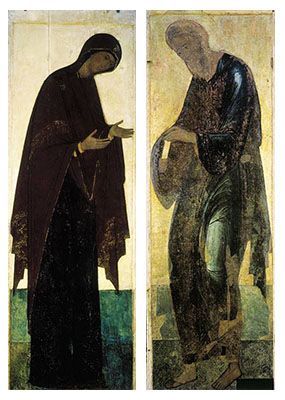
The Virgin Mary and St Andrew the First Called
These two paired-back depictions of The Virgin Mary and St Andrew from the Dormition Cathedral cannot be fully verified as Rublev's work; some believe Theophanes The Greek painted them and others think they were possibly the work of Daniil Cherny. Taken as Rublev's, however, they reveal a muted use of color that allows for a depth of sincerity and religious intensity that is wholly characteristic of his style. Indeed, it is possible to see the same noble piety in the downward cast eyes of both figures as is present in Rublev's other works (such as The Virgin of Vladimir).
The frescos and panels from the Dormition Cathedral in Vladimir have been restored numerous times, making it difficult to comment confidently or effectively on the nature of brushwork or the exact color choices. The movement of line and silhouette however can be largely relied upon as being faithful to the artist original decisions. The insistently minimal composition, and boldly sweeping downward lines, are significant in their departure from the more complex and intense icons of the Byzantine style of the time. They are thus examples of the simpler, more monumental work which was to be newly promoted through the Moscow School of Iconography.
Originally Dormition Cathedral, Vladimir
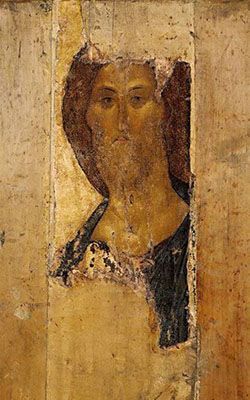
The Saviour
Rublev is believed to have painted icons for the "Zvenigorod Row," part of the iconostasis for one of the Zvenigorod churches. Three icons, The Saviour, Archangel Michael and Apostle Paul, all of whom are peaceful and serene figures, bear the painter's signature style: The Saviour is full of kindness and attention, Paul is presented as a deep thinking philosopher while Michael represents the beauty of all humankind.
Only the face and shoulders remain of The Saviour. Even in such a small section of work, however, the direct and gentle nature of the gaze has received the appreciation of both spiritual and secular audiences and is often seen as the beginning of Rublev's so-called "Golden Age." The elegant lines developed by the Novgorod School are evident in the contours of the face but they are also teamed with a subtle modelling of the skin that is incredibly progressive for the time. The face is simplified but still possess a piercing tenderness. This combination of minimalism and intense feeling is really, at this time, only seen elsewhere in the work of the early Italian renaissance masters such as Da Vinci.
Tempera on Wood - The Tretyakov Gallery, Moscow
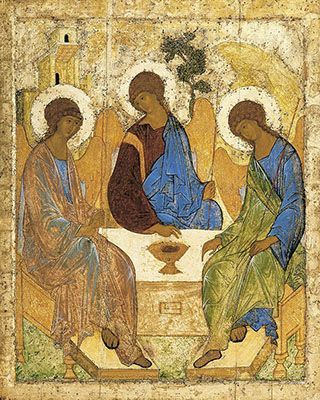
The Old Testament Trinity Icon
Rublev's masterpiece shows three angels sitting around a table in sacred conversation, blessing the head of a lamb in a goblet in the centre of the table. The icon depicts the story of the Hospitality of Abraham when three angels appeared in front of Abraham's tent beneath the Oak of Mamre. Abraham offered them refreshment as they tell him and his wife Sarah of Sarah's pregnancy.
There are many representations of this story in Byzantine and Russian Orthodox Art. The reason Rublev's painting is of such special significance lies in how he breaks with the conventions of the previous icons. He does away with the plot line choosing instead to focus on one moment. Neither Abraham nor Sarah are present, though their house, the oak of Mamre and Mount Moriah are shown in the background serving to place the viewer. Rather than simply tell a story through his painting, he describes a feeling, a moment of intense spiritual reflection and it is that spirituality he is offering up for the worshipper's reverie.
The symbolism of the piece focuses on one aspect of the story. In the New Testament, Abraham addresses the angels as a singular entity though they are always described as three. This is to illustrate their role as the embodiment of the combined trinity of the father, the son and the holy spirit. In his painting Rublev seats the angels in circle, looped in unity by their positioning and yet also open to the presence of the viewer, welcoming them into the holy contemplation.
The Spirit on the right has a sky-blue robe, draped in pale green, colors of the air, the Son in the centre is connected to the earth with his deep reddish-brown robe while the Father's robe seems to be of an undefinable color, transparent and shimmering. It is the pensive calm of this picture that was to to influence the Moscow School of painting and give Russian Iconography the recognisable Slavic softness associated with it today.
The Tretyakov Gallery, Moscow - Tempera on Wood
Biography of Andrei Rublev
Childhood
The exact date and place of Rublev's birth are unknown but it is likely he was born in the mid-to-late fourteenth century and was raised in the small town of Sergiev Posad near Moscow. It is a matter of historical record however that the Russia of the 1360s was a difficult and bloody country in which to live. Russia had been occupied by Tartar invaders who pillaged towns, monasteries and churches and took peasants into slavery, state control had been pushed back to the towns of Nizhniy Novgorod and Moscow, while the passage of fleeing people led to plagues in both cities during 1364 and 1366. In 1365, meanwhile, a fire had swept through Moscow destroying large parts of the city, taking many lives. These disasters were followed in 1371 by widespread famine, and soon thereafter, in 1378, Moscow was invaded by Lithuania's Prince Algirdas. There is no evidence to suggest that Rublev was directly affected by any of these events, but they do serve as a backdrop to the times in which he had grown up and possibly hint at his motivation to create the images of heavenly balance on which his legend is built.
It is fair to say that these were dark days for ordinary Russians, but the fact that Rublev has a surname, an endowment only possessed by nobility or dignitaries, suggests that his family enjoyed a level of wealth and status. Moreover, the name "Rublev" may have been an indicator of his family's trade: the name "Rublev" probably derives from the verb "rubit" (to cut wood) or from the noun "rubel" which is either a long wooden pole or a tool used by tanners. It is thought likely, too, that his Christian name was changed, with the name Andrei being bestowed on him only when he took his vows as a monk.
Education
In a chronicle in 1408 Rublev is described as both an artist and a "faster". Ascetism was a common practice among Russian Orthodox priests at the time and part of a monk's calling was to fast regularly. It is not known for certain where and when he took holy orders but it was likely to be The Holy Trinity Cathedral of St Sergius where he spent many years. It is possible too that at the time of his arrival at Trinity, the Father Superior Sergius of Radonezh himself may have been the hegemon, though is seems more likely that he was a monk under Nikon of Radonezh, Sergius's immediate successor. Whether or not Rublev arrived before or after Sergius' death (in 1392) however, the elder monk will have had a significant impact on Rublev's education. Indeed, Sergius was one of the most significant monastic reformers in Russian history and became a patron saint when the Russian Orthodox church canonised him in 1452. At the time of Rublev's monastic career his influence would have been all-pervasive.
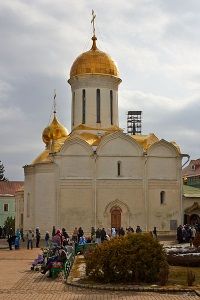
Sergius of Radonezh built the original wooden church of the trinity, with one small cell in which to live, during the early 14th Century with the help of an elder brother. Alone in the woods the siblings proceeded to live a life of ascetic piety and peacefulness, subsisting solely on what they could grow themselves. Though his brother would move on, news of Sergius's lifestyle quickly spread among monks in the surrounding area and very soon many had joined him, building basic living cells of their own. The site expanded quickly and his disciples left to spread word of his way of life to other monasteries thereby swiftly changing the running of monasteries in the wider surroundings. This quiet, pensive attitude to worship that the ascetic monks adopted permeated deeply during Rublev's religious education and indeed shines through in his art later in life.
Early Career
It is generally agreed that Rublev honed his artistic skill under the tutelage of Theophanes the Greek, a great muralist and iconographer in the Byzantine tradition. This supposition is based on the documentary evidence that (in reverse order) Rublev, Prokhor the Elder from Gorodets and Theophanes form the list of artists who provided frescoes and icons for the Cathedral of The Annunciation in The Kremlin in 1405. Though he was the junior (in rank and age) member of the team, the very fact that Rublev's name is recorded on such a prestigious commission indicates that he had already achieved a sound level of status.
The wooden Cathedral burnt down and was replaced in stone some years later, but the icons still remain, and though none of the work is signed, attributions have been made and largely agreed upon by art historians as to which man painted which icon. By comparing Theophanes's and Rublev's images, one finds that their religious outlooks differed quite considerably; in contrast to Rublev's heavenly optimism, Theophanes's overwrought and tragic images sat much more comfortably within the general trajectory of Byzantine Christian painting. It is not known therefore if the two artists were close theological companions but there are, however, clear links between the styles of the two artists.
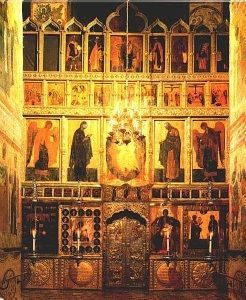
It is known that Theophanes the Greek moved to Novgorod in 1370 from Crimea. He was born and trained in art and philosophy in Constantinople and is described in contemporary accounts to be a very learned and thoughtful man. These qualities are evident in his work and can be seen thus as an influence on Rublev's own meditative approach to composition. Theophanes was a leader in both the Novgorod school of painting and, later, The Moscow School, and passed their developments and changes to the Byzantine tradition on to Rublev, who was to evolve them into a more distinctive and more self-confident Russian-national style.
Mature Career and Death
In 1408 Rublev was commissioned to decorate the Assumption Cathedral in Vladimir with Daniil Cherny (amongst others). Cherny and Rublev became friends and colleagues and are thought to have worked closely together over the proceeding two decades. Indeed, when Trinity St Sergius burnt down during a Tartar raid in 1408, the two men were invited to decorate its stone replacement. The surviving Cathedral frescos represent a fragment of the Doomsday composition but analyses of the frescos - the rhythm and gracefulness of the lines - could only belong to the hand of Rublev. Indeed, his interpretation of the scene was quite atypical with the Byzantine preference for the theme of fear of damnation being overtaken by the theme of forgiveness and enlightenment. It is thought by many that Rublev also painted his great masterpiece, and only proven work, The Trinity, or The Hospitality of Abraham to display in the new cathedral. The dating of The Trinity is, however, unknown though is thought to have been painted either in 1411 or on completion of the holy building somewhere between 1425-27. In either case, the Trinity icon has come to symbolize a new (and lasting) apex in Russian culture.
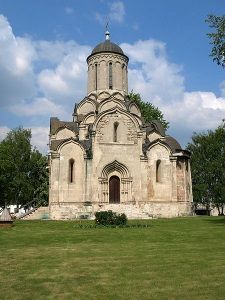
Following Cherny's death (he is buried at the St. Trinity monastery) Rublev moved to the Andronikov Monastery in Moscow where he painted the frescos, his last known works, for The Church of The Saviour. According to the letter of the saint Epiphanies the Wise, Rublev had worked as a labourer on the construction of the monastery while his frescos were painted between 1428 and his death in 1430. Today there is a museum in the monastery dedicated to Rublev.
The Legacy of Andrei Rublev
Though Rublev is now considered the greatest of all Russian medieval iconographers, and was probably well respected during his lifetime, he was not (re)discovered until the 20th Century when The Trinity was cleaned in 1904. His reputation grew to such an extent that by 1959 the Andronikov Monastery opened The Andrei Rublev Museum. His legend was further confirmed when the Russian Orthodox Church made Rublev a saint in 1988, the first Russian painter to be canonized. The church commemorates Rublev's life on 4 July.
Artistically, both the Moscow and Novgorod Schools of iconography have had huge impacts on modern art and Rublev as the leading light of the style especially. His minimal rhythmic approach to composition gave the abstract artists of the 20th century such as Constantin Brancusi, who, like Rublev, was driven by the search for the idealization of aesthetic form and the poetic evocation of spiritual thought, the starting points to explore the possibilities of pure non-figurative movement in their work. His mastery of color alongside spiritual symbolism inspired the work of Wassily Kandinsky, whose interest in Russian iconography is present throughout much of his work. Kandinsky claimed in Concerning the Spiritual in Art that "color is a power which directly influences the soul", an idea that, though claimed by Kandinsky over five hundred years later, is palpable in Rublev's work and that of subsequent iconographers.
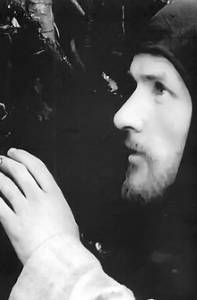
In 1966 Andrei Tarkovsky made a film based on Rublev's life and it is widely considered one of the greatest European art house films that succeeds in illustrating the pivotal role that Christianity and the art of Orthodox Iconography plays in Russia's self-image. Though he had little to work with by way of a recorded biography, Tarkovsky's three-hour-plus opus is generally considered an authentic representation of Rublev's life and of 15th century Russia. Indeed, Tarkovsky tells the story of Rublev's life through a series of "moments," a technique that pays homage to the iconographer's own method of working.
Influences and Connections

- Theophanes The Greek
- Prokhar of Gorodets
- Daniil Cherny
- St Sergius of Radonezh
- Nikon of Radonezh
- Byzantine Mannerism
- The Novgorod School
- Asceticism
-
![Wassily Kandinsky]() Wassily Kandinsky
Wassily Kandinsky -
![Constantin Brâncuși]() Constantin Brâncuși
Constantin Brâncuși - Dionysius
- Daniil Cherny
- The Moscow School
- Russian Orthodox Iconography
